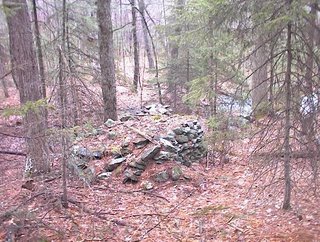 This is an unusual pile because from above, the outline looks like this:
This is an unusual pile because from above, the outline looks like this:  This certainly is turtle like, although possibly a person could stand on the flat upper surface and go out and stand on the extremity. Here is a view from above, pretty much what I spotted from the highway as we drove past the site:
This certainly is turtle like, although possibly a person could stand on the flat upper surface and go out and stand on the extremity. Here is a view from above, pretty much what I spotted from the highway as we drove past the site:  And here is a view of the spring which begins just here, underneath this prominent pile:
And here is a view of the spring which begins just here, underneath this prominent pile:  You can see the highway railing in the background.
You can see the highway railing in the background.A bit further downstream there were smaller piles, mostly on supports, clustered around the brook. In this panorama, there is a bit of a dam across the brook, at the right hand end of the picture.
 This is a neat place. Any one of these sites deserves better than to be blitzed like this. But that's what you do on a roadtrip. I hope someone will go spend some time looking more closely at these sites along Rt 202. I'll tell you about the others later.
This is a neat place. Any one of these sites deserves better than to be blitzed like this. But that's what you do on a roadtrip. I hope someone will go spend some time looking more closely at these sites along Rt 202. I'll tell you about the others later.
No comments :
Post a Comment